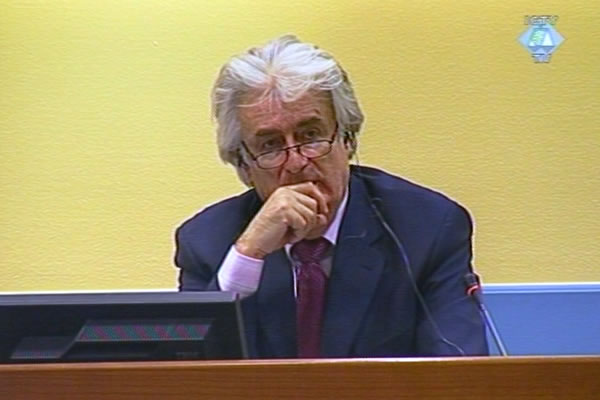Home
MAINTAINING ATMOSPHERE OF TERROR IN SARAJEVO
Former member of the UN peace-keeping force testifies at the trial of Radovan Karadzic under protective measures, a pseudonym and with voice and image distortion. The witness described how the Bosnian Serb forces ‘maintained an atmosphere of terror’ firing about 1,200 shells daily on Sarajevo and its inhabitants
 Radovan Karadzic in the courtroom
Radovan Karadzic in the courtroom
Former member of the UNPROFOR French contingent is testifying at the trial of Radovan Karadzic under the pseudonym KDZ 185 with voice and image distortion as protective measures. In the examination-in chief, the prosecution tendered into evidence the witness’s written statement given to the Tribunal’s investigators in 2009. In his statement, the witness described the Bosnian Serb artillery and sniper terror campaign against Sarajevo in the first half of 1993.
Prosecutor Carolyn Edgerton read out the summary of the witness’s statement. The witness arrived in Sarajevo in early 1993. In the first three months of the witness’s stay in Sarajevo, approximately 1,200 shells fell on the city every day. The witness highlighted 21 March 1993 as a particularly difficult day when about 2,400 shells hit the city, 400 on the old part of the city.
In his examination-in chief, the witness said the ‘primary goal’ of the shelling of Sarajevo was to terrorize the civil population ‘in order to force them to surrender’. Apart from using the artillery to support their military operations, the Serb forces used it to increase the psychological pressure on the people and the BH Presidency by ‘firing randomly’, the witness explained. The Serb forces sometimes shelled the city in retaliation for the BH Army attacks outside Sarajevo.
In the witness’s opinion, Stanislav Galic, who commanded the Sarajevo-Romanija Corps at the time, was ‘a great military professional’ who briefed his superior command ‘every evening’ on the events in the field. According to the witness, the fact that the shelling would stop immediately after a cease fire was agreed showed that the army had ‘a strict hierarchical structure’. This also shows that Galic ‘regularly’ consulted his superiors before making any decisions, the witness claimed.
In his written statement the witness described the shelling of the football pitch during a match in Dobrinja on 1 June 1993. The indictment alleges that more than ten persons were killed then and about 100 were injured. The crater analysis at the crime scene showed that the shells had been fired from the south-east, where the VRS artillery had its positions. The witness also described how the Bosnian Serb forces opened ‘indiscriminate’ fire on civilians as they ran across the airport runway. One third of the victims were women, children and elderly, the witness noted.
At the beginning of his cross-examination, Karadzic put it to the witness that ‘it was impossible to see in the dark’ if the people running across the airport runway were civilians or soldiers. Karadzic asked the witness if the Serbs would have acted differently if they had been able to distinguish civilians from soldiers. ‘I cannot tell, I can only say that I saw civilians – women, children and elderly – who were killed or injured by the Serb forces, on a number of occasions’, the witness replied.
Karadzic is expected to complete the cross-examination of the witness tomorrow. The next witness should be Momcilo Mandic, former Bosnian Serb justice minister.
Linked Reports
- Case : Karadzic
- 2010-06-23 WHAT THE WITNESS ‘HAD TO KNOW’
- 2010-06-22 KARADZIC DEFENDS MLADIC
- 2010-06-21 KARADZIC’S ‘CARE’ FOR CIVILIANS IN SARAJEVO
- 2010-06-29 KARADZIC’S ‘ACCURATE AND DETAILED EVIDENCE’
- 2010-06-30 KARADZIC’S PICTURE OF WARTIME SARAJEVO
- 2010-07-01 DID EXTREMISTS ‘CURRY FAVOR’ WITH KARADZIC OR KRAJISNIK?
